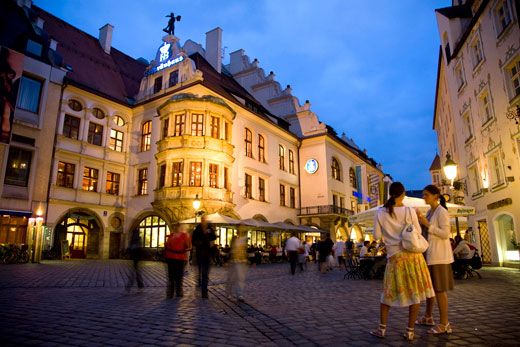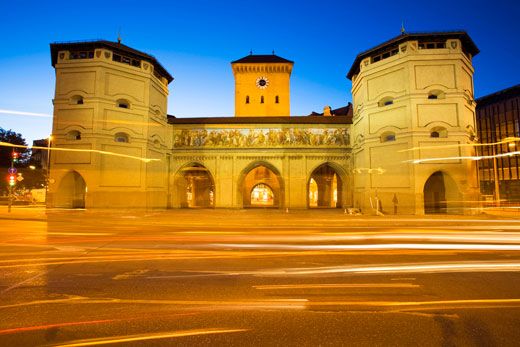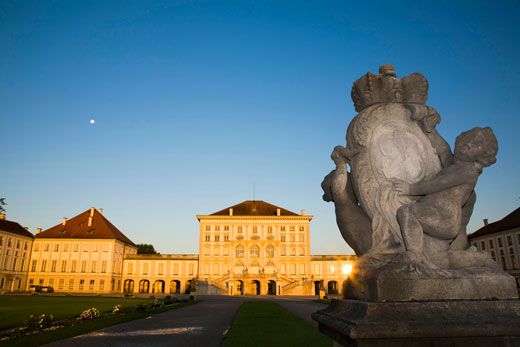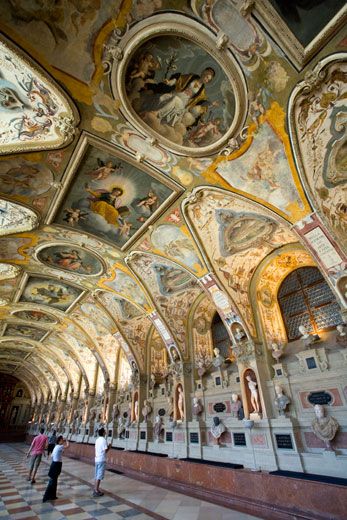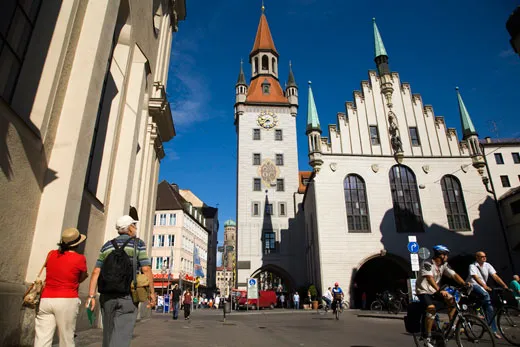Munich at 850
The livable, culture-crazy, beer-loving capital of Bavaria is coming to terms with its history
/https://tf-cmsv2-smithsonianmag-media.s3.amazonaws.com/filer/munich_nov08_631.jpg)
The Hofbräukeller beer garden in the Munich borough of Haidhausen was filled to capacity. Perhaps a thousand people, most in their 20s and 30s, sat shoulder to shoulder at long tables, quaffing liters of beer, munching on fat pretzels and maintaining a steady roar of bonhomie. It was a poster-perfect moment in a city that has long advertised itself as a citadel of good fellowship fueled by unending quantities of the world's best beer. But it was also a scene that would not have looked precisely like this just a few years ago. Almost to a person, the beer drinkers were wearing their national colors—red, yellow and black—in support of the German soccer team's chances against Turkey in the semifinals of the 2008 Euro Cup in Switzerland.
Under a canopy of chestnut trees, TV screens had been set up to show the match. With the playing of the German national anthem, many in the garden stood and, to Haydn's imperial melody, sang, "Einigkeit und Recht und Freiheit/ Für das deutsche Vaterland!" ("Unity and justice and freedom/ For the German fatherland!"). Absent was the notorious phrase "Deutschland, Deutschland über Alles!" ("Germany, Germany above all!"), which the Nazis exploited into a boast of German superiority and which was dropped from the anthem after the war. "Until two years ago when Germany hosted the World Cup finals," said a young man next to me, "this display of patriotism would have been unthinkable. We would have been too embarrassed."
It has taken more than half a century for Munich, which this year marks its 850th anniversary, to restore national pride to its considerable array of things to be proud of. Germany's third-largest city (after Berlin and Hamburg) and the capital of the state of Bavaria, Munich has long prided itself on easygoing sophistication and love of hearty pleasures—while standing distinctly apart. In Thomas Wolfe's novel The Web and the Rock, the narrator observes, Munich "is a kind of German heaven....a great Germanic dream translated into life....In other parts of Germany, people will lift their eyes and sigh rapturously when you say you are going to Munich: 'Ach! München...ist schön!'" (Schön means handsome, beautiful and nice.)
Novelist Thomas Mann, who lived in Munich before fleeing to America after Hitler came to power, began his short story "Gladius Dei" with what is perhaps the most famous description of the city's charms: "Munich was resplendent. A shining vault of silky blue sky stood above the festive squares, the white colonnades, the classicistic monuments and baroque churches, the leaping fountains, palaces and parks of the capital city, and its broad bright vistas, tree-lined and beautifully proportioned, basked in the shimmering haze of a fine early June day."
As often happens in a Mann story, the mood soon darkens —in this case with the appearance of a fanatical reformer who resolves to destroy the city's luxuries in a great bonfire. Published in 1902, the story uncannily foreshadows developments that were to make the name Munich synonymous with some of the direst events of the 20th century: the birth of Nazism; the British, French and Italian appeasement of Hitler in 1938; the massacre of 11 Israeli athletes by Palestinian terrorists at the 1972 Olympics. As I joined in the cheering for Germany's eventual victory over Turkey, I reminded myself that it was in this very Hofbräukeller in 1919 that Hitler gave his first public political speech.
Munich suffered extensive damage during World War II—Allied air raids struck the city 71 times. After the war, it was meticulously rebuilt to look as much as possible as it did before 1940. In the process, the city fathers demolished or masked many buildings related to the Third Reich. Hitler's Munich, a grim travel guide by businessman turned writer Joachim von Halasz, identifies 35 that still survive, many vital to Hitler's rise and reign but now used for benign purposes. They include Munich's top tourist attraction, the world-famous Hofbräuhaus beer hall; the city's oldest grand hotel, the Vier Jahreszeiten Kempinski; and the banqueting salon in the Altes Rathaus (Old Town Hall), where Joseph Goebbels orchestrated Kristallnacht (Night of Broken Glass), during which thousands of Jewish-owned businesses, homes and synagogues throughout Germany were vandalized or destroyed, approximately 100 Jews were killed and some 30,000 others were sent to concentration camps, many going to Dachau, just outside Munich.
In recent years, Munich has consistently been rated among the world's most livable cities, thanks to its seamless blending of the modern with the medieval, the spaciousness of its public gardens and avenues, its standing as Germany's most prosperous city, its world-class cultural attractions, its superb public transportation and its manageable population of 1.3 million. Munich is one of those rare major cities that feel cozy. Germans call it "Millionendorf"—"village of a million people."
Munich also enjoys a reputation as one of Europe's safest cities. Walking from the beer garden back to my hotel near midnight, I crossed the Isar River, with its rushing water and lush, green banks, strolled along Maximilianstrasse, past shops with such names as Cartier, Dior and Vuitton, and finally entered the maze of narrow streets in Altstadt (Old Town). Hearing the sound of my shoes on the pavement, I felt as though I had this beautiful town entirely to myself.
"Munich has always had a sense of itself as a special city," says Thomas Weidner, senior curator of the City Museum on St.-Jakobs-Platz. "We are apt to think of ourselves more as Münchners than as Bavarians." We were standing before the inscrutable figure of Henry the Lion, a member of the Welf dynasty and Duke of Bavaria and Saxony, who, it is generally thought, founded Munich in 1158 by tearing down an old bridge over the Isar and constructing a new one along the region's ancient salt-trade route. Nearby was a settlement of monks (Mönche), which, according to some accounts, gave the city its name. In 1180, Henry lost Bavaria to a rival ducal family—the Wittelsbachs. Their members ruled Bavaria for the next seven and a half centuries. In 1918, after Germany's humiliating defeat in World War I, a popular revolution led by Jewish socialist Kurt Eisner unseated the last Wittelsbach monarch, King Ludwig III, and Bavaria became a republic. Eisner was assassinated shortly after becoming the new republic's first prime minister; the resulting political instability proved to be fertile ground for the rise of Nazism.
Weidner said the museum had just completed a reorganization of its holdings so that an exhibition of the city's 850-year history could be displayed chronologically for the first time. As he guided me through four floors of displays, I began to appreciate how Munich was able to forge its remarkable self-esteem. Foremost was the Wittelsbachs' durability, which stamped the city with the successive rulers' personal tastes and gave it unusual continuity and stability. Also in evidence in the exhibitions was the city's long-standing adherence to the Roman Catholic faith, which has set it apart from its Protestant neighbors in the north and east of Germany. Above all, it was clear that for centuries the city fathers had shown an extraordinary willingness to adapt foreign influences to their own ends.
Munich's town plan has remained essentially unchanged since the late 1500s, when it consisted of four quadrants laid out on the grid of a cross—a scheme readily discernible in one of the museum's models illustrating the city's evolution from a poky market town to the most important urban center in southern Germany. I remarked on the exotic, onion-shaped domes that still crown the twin towers of the massive Gothic cathedral in the city's center, the Frauenkirche (Church of Our Lady), which was built in the late 15th century. The domes were added several decades later. "At first, the people hated those 'foreign' domes," said Weidner, "but now they're prized as distinctively 'Munich.' Today, no building in the city can be higher than the Frauenkirche towers."
A model of 19th-century Munich showed wide boulevards lined with neo-Classical facades. "This is the influence of King Ludwig I," said Weidner. "In my opinion, he was determined to surpass the grandeur that Napoleon brought to Paris." Stopping before an alluring portrait of an exotic woman, Weidner told me she was Ludwig's mistress Lola Montez, a "Spanish" dancer and courtesan of Irish birth, whose tempestuous hold over the king led in part to his abdication in 1848.
In a heavily rural state that prides itself for upholding tradition, Munich is also notable for its adaptability. The city, which remained a walled Catholic stronghold in the 16th and 17th centuries after the Reformation, promoted a cult of the Virgin Mary (hence the name of the central square, Marienplatz). Yet in response to the German Enlightenment of the 18th century, the city fathers took down the surrounding medieval wall, leaving a few still-standing gates as evidence of the past while embracing the wider world.
Another example of Munich's openness is the city's great Englischer Garten (English Garden), one of the largest urban public parks in the world. It was designed in 1789 by Benjamin Thompson (later Count von Rumford), a polymath from Woburn, Massachusetts, who also brought the cultivation of potatoes to Bavaria, where he invented a double boiler, drip coffeepot, kitchen range and "Rumford Soup," a nutritious broth for the poor.
The City Museum's neighbor on St.-Jakobs-Platz is the new Jewish Center—three buildings housing a community center, a museum and a synagogue. By 1945, Munich's Jewish population had plummeted from more than 10,000 to 84. Since 1991, when Germany began officially welcoming Jewish refugees from the former Soviet Union, the number of Jews in the city has swelled to 9,585. The new Ohel Jakob synagogue, which opened in 2006, marks the visible return of Jewish life to the city center for the first time since 1938. Shortly before destroying the original Ohel Jakob synagogue during Kristallnacht that year, the Nazis had forced the city's Jews to tear down their own main synagogue on Herzog-Max-Strasse. The new complex is situated close to the great open-air Viktualienmarkt (food market), whose beer gardens and overflowing bins of vegetables, meat and fish bring residents together from dawn to dusk. As Charlotte Knobloch, a Holocaust survivor who spearheaded the building of the Jewish Center, noted, Munich has now restored to the city a place where "Jews and non-Jews [can] meet in the middle."
In a city whose love of the picturesque can overwhelm a visitor, I found the stark, monumental synagogue an inspiring statement. From an opaque base of Wailing Wall-like stone rises a glass cube enclosed in a protective bronze web—a suspended lantern that expresses the Bible's opening injunction, "Let there be light." Inside, the names of 4,500 Munich Jews murdered by the Nazis line a 105-foot-long "Corridor of Memory."
"For too long Munich's Jews, living and dead, did not have a place where they could be seen," Ellen Presser, the center's cultural director, told me. "Now it is here."
A short walk across town is the city's grandest building—the former palace of the Wittelsbachs, known simply as the Residenz. Despite its imposing Renaissance facade and size (a vast complex built around seven courtyards), it nestles comfortably amid the pedestrian-friendly streets and squares that constitute the city's commercial and historic hub. The spectacularly decorated rooms are open to the public and well worth seeing. But on this visit, I opted for the Wittelsbachs' suburban summer palace, Nymphenburg, a 20-minute tram ride from Marienplatz.
Begun in 1664 and greatly expanded over the next century, Schloss Nymphenburg (Nymphenburg Palace) rivals the Palace of Versailles for the majesty of its facade and decoration of its salons. The geometric layout of the gardens extends to an immense meadow and thickly wooded park that brings the sumptuous Bavarian countryside to the city's edge. The park contains what may be the most elegant fun house ever built—the diminutive Amalienburg hunting lodge, which Belgian architect François de Cuvilliés designed in the 18th century for Charles VII and his Austrian wife, Maria Amalia. As if the excitement of the royal hunt were not enough, Cuvilliés contrived a central room that is architecture as pure delirium—a fanciful Hall of Mirrors that is considered the epitome of the German Rococo style. As my eyes swam in the myriad reflections and dancing light created by the voluptuous mirrored and silvered surfaces, I imagined that Cuvilliés, a tiny man who first caught the attention of one of the Wittelsbachs as a court dwarf, might have been thumbing his nose at Louis XIV by making so much magic in a space a fraction the size of the Sun King's Hall of Mirrors at Versailles.
Cuvilliés is perhaps the star of Munich's 850th anniversary year. My visit coincided with the reopening of the city's most beloved theater—a Rococo opera house in the Residenz that the architect designed in the 1750s for Maximilian III Joseph. During the war, Allied bombs destroyed the shell of the old Cuvilliés-Theater. But much of its ornate interior was rescued before the bombing, and the theater was reconstructed in the 1950s. Four years ago, the Cuvilliés again closed for restoration and modernization—a project that eventually cost €25 million, or about $36 million. For the reopening in June 2008, the Bavarian State Opera staged a new production of Mozart's Idomeneo, which had its world première at the original Cuvilliés in 1781.
Court opera in the 18th century was an occasion to see and be seen, and with its 523-seat intimacy, rose-colored upholstery, lavishly gilded trim and softly sparkling chandeliers, the new Cuvilliés-Theater will make anyone in jeans and sneakers feel woefully out of place. Münchners take their opera very seriously, and the crowd for Idomeneo was dressed to the nines.
Several days later, I joined many of them again around the corner at the State Opera's principal venue, the National Theater, for a stirring performance of Wagner's Tristan und Isolde, which had its world première in Munich in 1865. The opera began at 4 p.m. so there would be plenty of time for dinner between acts, dessert at the Spatenhaus an der Oper café and restaurant across the square when the performance ended at 10 p.m., and drinks at Schumann's bar on Odeonsplatz. Opera-going may be a serious endeavor in Munich, but it's also relaxed—honed by centuries of habit, and part and parcel with the laid-back rhythms of the city.
With a population considerably smaller than that of New York City, London, Paris or Berlin, Munich has long supported not one but three world-class symphony orchestras—the Munich Philharmonic, the Bavarian State Orchestra and the Bavarian Radio Symphony Orchestra. Not even a lack of air conditioning on a warm summer evening could keep a capacity crowd in the stifling Hercules Hall in the Residenz from sitting raptly through a performance of Dvorak and Mahler by the Bavarian Radio Orchestra, conducted by the young English maestro Daniel Harding. As I dabbed my brow, a man next to me smiled and said, "We Germans like to suffer a little bit for our art."
Although the Schwabing district in the northern part of the city enjoyed a certain reputation for artistic ferment at the turn of the last century (Klee and Kandinsky both spent several years there), Munich never attained anything like the stature of Vienna, Paris or Berlin for cultivation of great art. But collecting it is another story, and Munich has concentrated its finest art in one place—an ensemble of galleries whose displays range from the sculpture of ancient Greece and Rome to the latest fancies by contemporary artists. The galleries' holdings are so vast that they are best sampled over three or four days. Nonetheless, it's possible, as I did one extended morning, for the hardy art lover to walk through 2,500 years of art, making a judicious sampling along the way.
Ludwig I's Glyptothek museum, which was built between 1816 and 1830 to showcase the king's interest in Classical antiquity, greets visitors with one of the world's most erotic sculptures—the life-size marble Barberini Faun, a sleeping satyr from circa 220 b.c., whose wanton nudity startles even today.
At the Alte Pinakothek, whose facade still shows the scars of the bombing it suffered in World War II, the prize for me among better-known works by Dürer, Breugel, Titian, El Greco and Rubens is The Mystic Marriage of St. Catherine, from 1505-08, by the Northern Italian master Lorenzo Lotto. The painting manages to be both creepily otherworldly and sweetly realistic.
The Neue Pinakothek, which houses 18th-, 19th- and early 20th-century art, was so badly damaged during the war that it had to be entirely rebuilt. The building's generous natural light bathes its collection of French Impressionists, British portraitists and German Realists and Symbolists in a wonderful glow. On my most recent visit, I was especially taken with the paintings of the German Impressionist Max Liebermann, whose scenes of German life, from beaches to beer halls, show a depth and delicacy that, to my eye, make paintings by his more acclaimed French counterpart, Édouard Manet, look effete.
Munich's Pinakothek der Moderne is one of the world's most impressive museums of modern art. Stark white, severely rectilinear with soaring spaces, the building, designed by the German architect Stephan Braunfels, still felt a bit too modern—cold and clinical—six years after I first visited when it opened in 2002. All the important 20th-century names are here, from Braque to Baldessari, but the most delightful rooms belong to the museum's immense holdings of industrial design—from the 19th-century bentwood chairs of Michael Thonet to Danish-born artist Olafur Eliasson's 2008 hydrogen-powered racing BMW, clad in a skin of ice, which was on loan from the BMW art car collection.
I had to wrap myself in a blanket, provided by one of the guards, to withstand the gallery's chill, but I was so intrigued by this icemobile that later that afternoon I ventured by subway to the BMW Museum in Olympic Park on the outskirts of town. The place was packed, mostly with fathers and sons, who tiptoed along the Erector Set-like catwalks as if they were in a cathedral. It was, indeed, something to see: the company's first product, a 1916 aircraft engine; motorcycles used in World War II; an eye-popping succession of brightly painted roadsters, convertibles, sedans, racing cars and limousines—all further evidence of Münchners' genius for aesthetic display.
Munich's best restaurants, which include an unusually good assortment of Italian ones, rival their counterparts in other popular European cities, but the food closest to the Münchners' collective heart is undoubtedly Weisswurst, white veal sausage smeared with sweet mustard and washed down with beer. Any of the products of Munich's famous "big six" breweries—Augustiner, Paulaner, Hofbräu, Löwenbräu, Spaten and Hacker-Pschorr—will do, but traditionalists prefer Weiss (white) beer, made mostly from wheat. They will also tell you that you should consume freshly boiled Weisswurst only at breakfast—or at least not later than noon—in memory of the days when a lack of refrigeration spelled afternoon spoilage of meat.
On my last morning in Munich, I joined Wolfgang Stempfl, the dean of Doemens Academy, the city's renowned institute for aspiring beer makers, to sample this classic combination. At his suggestion we met at 10 a.m. in the Weisses Bräuhaus, a 450-year-old establishment in Old Town. The plain wooden tables in the cavernous, heavy-beamed main dining room were filled with connoisseurs of the house specialty.
I couldn't remember the last time I had had beer for breakfast, but that morning's half-liter went down as easily as orange juice. When I lifted the lid off a small pan of two white sausages immersed in a bath of steaming water, the aroma made me swoon. The veal filling was soft as a down pillow, its flavor delicate yet satisfying. A healthy dab of brown mustard jolted me into wanting more. I reached for another bite.
"You like it?" Stempfl asked.
"I could start my day like this every day," I replied.
We talked about his role in educating aspiring brewers about traditional craftsmanship, and about the upcoming Oktoberfest, the annual beer orgy, which fills every hotel room in Munich. Stempfl said he continues to enjoy the event despite its rampant commercialism, but is dismayed that younger Germans are beginning to opt for lighter American-style beer or even fruit-flavored varieties. I asked what he thought was the best Munich beer.
"Augustiner," he said, naming a brew that was first made by Augustine monks in 1328. "It's the oldest Munich beer, and the most distinctive."
"Why?" I asked.
"Nobody knows," said Stempfl. "Maybe it's the water they use from their 750-foot well. Maybe it's something in the unusually complicated brewing process. It's a mystery."
"Would most people in Munich agree with you?" I asked.
"Yes," Stempfl quickly answered.
"So people just know," I said.
"That's right," he said. "In Munich, people just know."
Charles Michener write about culture and the fine arts.
Photographer Toni Anzenberger's favorite traveling companion is his dog Pecorino, who graced Smithsonian's March 2006 cover.
Planning Your Next Trip?
Explore great travel deals
Smithsonian magazine participates in affiliate link advertising programs. If you purchase an item through these links, we receive a commission.
